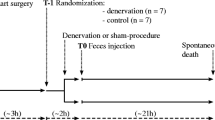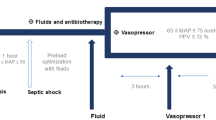Abstract
Objective
To determine the dose-response effects of noradrenaline on the systemic and renal circulations during septic shock.
Design and setting
Prospective controlled experiment in a university animal laboratory.
Subjects
Eight anaesthetized dogs.
Interventions
Transonic flow probes were surgically placed on the aorta via a left lateral thoracotomy and on the left renal artery. Blood pressure was measured from the femoral artery. Acute bacteraemia shock was induced by injecting Escherishia coli bacteria intravenously. Increasing doses of noradrenaline (0.1, 0.2, 0.3, 0.4, 0.5 µg kg−1 min−1) were infused intravenously for 30 min at 30-min intervals. The model was first validated in four dogs.
Measurements and results
Mean arterial pressure, central venous pressure, cardiac output, and renal blood flow were measured. Systemic vascular resistance was derived. Induction of bacteraemia decreased mean arterial pressure, central venous pressure and systemic vascular resistance. Cardiac output slightly increased. Noradrenaline produced linear dose-dependent increases in both mean arterial pressure and systemic vascular resistance. The response was attenuated during bacteraemia. Under non-bacteraemic conditions the maximum dose of noradrenaline reduced the renal blood flow from 12±1 to 10±1 ml kg−1 min−1. Bacteraemia further reduced renal blood flow to 7±1 ml kg−1 min−1, which was partly restored by the maximum dose of noradrenaline to 11±3 ml kg−1 min−1.
Conclusions
Noradrenaline can restore mean arterial pressure in bacteraemic shock and increases in mean arterial pressure are dose-dependent. The noradrenaline response is attenuated by bacteraemic shock. In bacteraemic shock noradrenaline also improves renal perfusion, as perfusion pressure increases. However, renal blood flow is not fully restored, suggesting that an element of impairment of renal blood flow exists due to the bacteraemia or noradrenaline.




Similar content being viewed by others
References
Hollenberg SM, Ahrens TS, Annane D, Astiz ME, Chalfin DB, Dasta JF, Heard SO, Martin C, Napolitano LM, Susla GM, Totaro R, Vincent JL, Zanotti-Cavazzoni S (2004) Practice parameters for hemodynamic support of sepsis in adult patients: 2004 update. Crit Care Med 32:1928–1948
Guzman JA, Rosado AE, Kruse JA (2003) Vasopressin vs. norepinephrine in endotoxic shock: systemic, renal, and splanchnic hemodynamics and oxygen transport effects. J Appl Physiol 95:803–809
Kellum JA, Pinsky MR (2002) Use of vasopressor agents in critically ill patients. Curr Opin Crit Care 8:236–241
Richer M, Robert S, Lebel M (1996) Renal hemodynamics during norepinephrine and low-dose dopamine infusions in man. Crit Care Med 24:1150–1156
Treggiari MM, Romand JA, Burgener D, Suter PM, Aneman A (2002) Effects of increasing norepinephrine dosage on regional blood flow in a porcine model of endotoxin shock. Crit Care Med 30:1334–1339
Bellomo R, Kellum JA, Wisniewski SR, Pinsky MR (1999) Effects of norepinephrine on the renal vasculature in normal and endotoxemic dogs. Am J Respir Crit Care Med 4:1186–1192
Di Giantomasso D, May CN, Bellomo R (2002) Norepinephrine and vital organ blood flow. Intensive Care Med 28 1804–1809
Di Giantomasso D, May CN, Bellomo R (2003) Norepinephrine and Vital organ blood flow during experimental hyperdynamic sepsis. Intensive Care Med 29:1774–1781
Bednarik JA, May CN (1995) Evaluation of a transit-time system for the chronic measurement of blood flow in conscious sheep. J Appl Physiol 78:524–530
Schaer GL, Fink MP, Parrillo JE (1985) Norepinephrine alone versus norepinephrine plus low-dose dopamine: enhanced renal blood flow with combination pressor therapy. Crit Care Med 13:492–496
Hoogenberg K, Smit AJ, Girbes AR (1998) Effects of low-dose dopamine on renal and systemic hemodynamics during incremental norepinephrine infusion in healthy volunteers. Crit Care Med 26:260–265
Schetz M (2002) Vasopressors and the kidney. Blood Purif 20:243–251
Acknowledgements
We thank Mr. Anthony E. James, the Director of Laboratory Animals Services Centre of The Chinese University of Hong Kong, and his staff for their support and making this study possible. We also thank Mr. David Burrows and his staff at the Agriculture, Fisheries and Conservation Department of the Hong Kong Government for providing the animals used in this study.
Author information
Authors and Affiliations
Corresponding author
Additional information
This article refers to the editorial available at http://dx.doi.org/10.1007/s00134-005-2740-z
Electronic Supplementary Material
Rights and permissions
About this article
Cite this article
Peng, ZY., Critchley, L.A.H. & Fok, B.S.P. The effects of increasing doses of noradrenaline on systemic and renal circulations in acute bacteraemic dogs. Intensive Care Med 31, 1558–1563 (2005). https://doi.org/10.1007/s00134-005-2741-y
Received:
Accepted:
Published:
Issue Date:
DOI: https://doi.org/10.1007/s00134-005-2741-y




